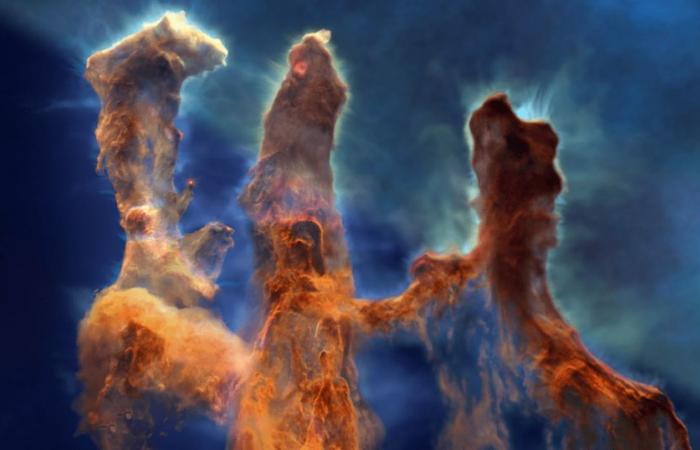
Comparison of how the Pillars of Creation look with the James Webb telescope (left) and the Hubble telescope (right) in the Eagle Nebula. Photo: NASA
6,500 light years from Earth, The Pillars of Creation, elephant trunks of interstellar gas, continue to fascinate astronomers since the Hubble Telescope photographed them on April 1, 1995 in the Eagle Nebula. NASA has made available to us a video with 3D technology to compare how we now see this sector of the universe through the James Webb telescope.
The tallest pillar measures three light years. To give us an idea of its immensity, this represents three quarters of the distance between the Sun and the nearest star, Alpha Centauri.
NASA: the 3D video of the majestic Pillars of Creation
The Pillars of Creationcaptured by the Hubble Space Telescope of the POT in 1995 from the Eagle Nebula, they are famous for their impressive beauty and curious shape. Now, the US space agency has published an updated 3D visualization of this structure in the sector, also called M16, using data from James Webb and the aforementioned. This new film, to date, offers a detailed, multi-wavelength view of the clouds where stars are born.
By peering between the pillars, viewers can appreciate their three-dimensional structure and notice the differences between Hubble’s visible-light view and Webb’s infrared view, said Frank Summers, senior imaging scientist at the Space Telescope Science Institute (STScI) in Baltimore. “The contrast helps them understand why we have more than one space telescope looking at different aspects of the same object,” Summers added.
The Pillars of Creationcomposed mostly of cold molecular hydrogen and dust, are being eroded by winds and ultraviolet light from nearby hot, young stars. Finger-like structures larger than the solar system extend from the tops of the pillars, where stars may be forming. The tallest pillar measures three light-years — three-quarters of the distance between our Sun and the nearest sphere of plasma, Alpha Centauri.
Wide-field image of the Eagle Nebula. Photo: ESO
The joint work of the James Webb Space Telescope and NASA’s Hubble
The film is based on observational data from a study led by Anna McLeod of Durham University, who was also a scientific advisor on the project. “The Pillars of Creation were always in our minds to create in 3D. The Webb data combined with the Hubble data allowed us to see the Pillars in more detail,” said production leader Greg Bacon of STScI. “Understanding the science and how to best represent it allowed our small, talented team to rise to the challenge of visualizing this iconic structure.”
The new visualization shows how two of The most powerful space telescopes in the world They work together to provide a more complete picture of the pillars. Hubble captures objects in visible light, while James Webb, using its infrared vision thanks to the technological instruments it carries, penetrates the dark dust to reveal the stars within them.
Interlaced images of the Pillars of Creation made by NASA’s Webb and Hubble. Photo: NASA
“When we combine observations from NASA’s space telescopes across different wavelengths of light, we expand our understanding of the universe,” said Mark Clampin, director of the Astrophysics Division at NASA Headquarters.
The visualization reveals several stages of star formation. Approaching the central pillar, a bright protostar is observed in infrared light. Near the top of the left pillar, a jet of material ejected from a newborn star is visible, although the star itself cannot be seen. On one of the ‘fingers’ of the left pillar, a new star shines brightly.
The Pillars of Creation and their incredible 3D printable model
A 3D printable model of the Pillars of Creation has been created and is available for download. “Examining the structure of the pillars in this tactile and interactive way adds new perspectives and insights to the overall experience,” notes a statement from the US space agency.
Additional visualizations and educational resources are available through NASA’s Learning Universe, such as ViewSpace, a video exhibit featured in nearly 200 museums and planetariums across the United States. Visitors can use interactive tools to explore images from space telescopes.





